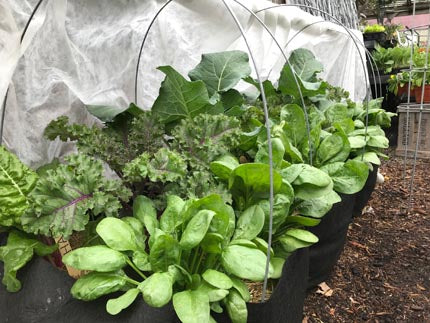
Planting your April Food Garden
Nancy DuBruleShare
Lots of folks think that the magical date to plant their vegetable garden is Memorial Day. Nothing could be farther from the truth! Yes, the end of May is the ideal time to plant warm season crops like tomatoes, pepper, and eggplant seedlings and direct seed beans, squashes, cucumbers, and corn. BUT, you are completely missing out on a very important planting window if you don't plant in April.

Peas need to be planted in early April so they can grow their vines to the top of the fence before it gets too hot, which makes them flower and form peas.
April is prime time for cool season crops. Not only can these edibles tolerate the cool nights and light frosts that are sure to occur in early spring, most of them NEED these conditions to thrive.
A good example is peas. They should be planted as early as the ground can be worked. Why? Because, when the weather is cool, peas grow leafy vines. Lots and lots of them. As soon as it gets really hot, they flower and then, make peas. If you plant them too late, they will only grow a little bit before making peas and you will get a very meager crop. I love to grow edible podded sugar snap peas. I grow a variety that gets tall. I put strong 6 foot oak stakes in the ground, attach chicken wire fencing all the way to the top with a staple gun, and then plant my seeds. My goal is to get them to the TOP of the fencing before they even think of flowering. I have done this every year I have been gardening, always in April. And I always get an amazing crop in July, enough to eat fresh and to freeze.
Another cool season crop must be planted in April are radishes. Again, they won't work if you plant them in hot weather. High temperatures cause them to bolt to seed. When this happens, the delicious swollen radish roots don't form. Radishes only take 28 days from seed to first harvest. I like to plant them many times in April to double or triple my harvest. Then I have to wait until fall to plant them again (but that is another blog post!)

I planted lettuce seeds and cilantro seeds together in this urn. Both can take the cool temperatures of April.
Lettuce also needs to be planted in the cool months or it too will bolt to seed. Lettuce can take temperatures down to just about freezing. If the forecast is that it will get colder than that, you simply have to protect your lettuce plants with floating row covers or cotton sheets. Never use plastic as it will transmit the freezing cold temperatures! I like to plant lettuce seedlings AND lettuce seeds at the same time. The same goes for escarole, spinach, and kale. When the main heads of these delicious greens are harvested, the baby seedlings will have room to grow and mature.

Kale is the ideal cool season crop. It can be direct sown or, better yet, plant seedlings and seeds to double your harvest. Don't forget the floating row covers to keep the cabbage worms off!
Lots of plants in the kale family are also cool season vegetables. April is the time to plant out pre-started seedlings of broccoli, cabbage, cauliflower, broccoli raab, and Brussel sprouts. You can't direct seed them in April as they won't have time to mature before the weather gets too hot. If you didn't get around to starting them indoors ahead of time, don't worry. Natureworks carries an excellent selection of cool season vegetable seedlings.

You should start direct sowing carrot seeds as soon as the ground can be worked in April. Keep sowing for the next few months and then again in late summer for a fall crop.
Mustard greens, leeks, onions, scallions, sorrel, parsley, sage, and rosemary can also be planted in April. You can direct seed carrots and beets as well.

Look at how gorgeous the kale and spinach are growing under the floating row covers. We pulled it back to harvest. We use wooden clothespins to clip it to the wire row cover hoops. These two crops were planted in April and have doubled in size the first month.
Your two best tools for planting in April are a soil thermometer and floating row covers and hoops. The soil thermometer is the only accurate way to know if your soil is ready for seeds and seedlings. If you rush it and the soil is too cold, the seeds may not sprout and the seedlings may be stunted or perish. The floating row covers are a quick way to protect plants from cold snaps. Some cold crops really need row covers to protect them from pests- kale, broccoli, cabbage, cauliflower, spinach, and Swiss chard are best planted from day one beneath row covers. But, having extra floating row covers at hand, along with old fashioned wooden clothespins, means you can quickly toss together a bit of frost protection that won't damage the rest of your plants that are not already under cover and then remove it the next morning when it warms up.
Give cool season crops a try this spring...and again this fall!

